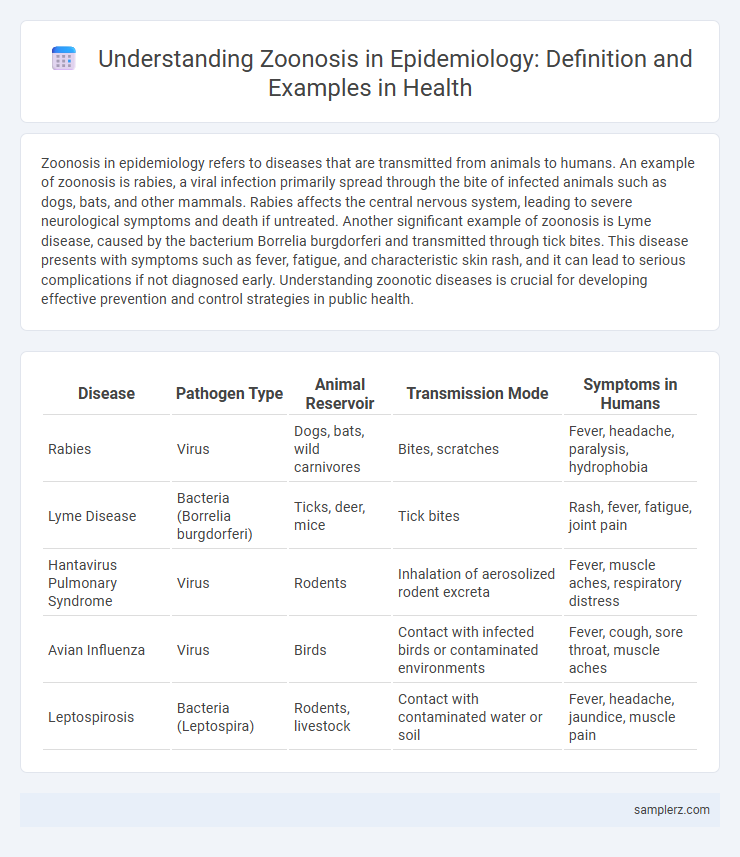Zoonosis in epidemiology refers to diseases that are transmitted from animals to humans. An example of zoonosis is rabies, a viral infection primarily spread through the bite of infected animals such as dogs, bats, and other mammals. Rabies affects the central nervous system, leading to severe neurological symptoms and death if untreated. Another significant example of zoonosis is Lyme disease, caused by the bacterium Borrelia burgdorferi and transmitted through tick bites. This disease presents with symptoms such as fever, fatigue, and characteristic skin rash, and it can lead to serious complications if not diagnosed early. Understanding zoonotic diseases is crucial for developing effective prevention and control strategies in public health.
Table of Comparison
| Disease | Pathogen Type | Animal Reservoir | Transmission Mode | Symptoms in Humans |
|---|---|---|---|---|
| Rabies | Virus | Dogs, bats, wild carnivores | Bites, scratches | Fever, headache, paralysis, hydrophobia |
| Lyme Disease | Bacteria (Borrelia burgdorferi) | Ticks, deer, mice | Tick bites | Rash, fever, fatigue, joint pain |
| Hantavirus Pulmonary Syndrome | Virus | Rodents | Inhalation of aerosolized rodent excreta | Fever, muscle aches, respiratory distress |
| Avian Influenza | Virus | Birds | Contact with infected birds or contaminated environments | Fever, cough, sore throat, muscle aches |
| Leptospirosis | Bacteria (Leptospira) | Rodents, livestock | Contact with contaminated water or soil | Fever, headache, jaundice, muscle pain |
Common Zoonotic Diseases Affecting Humans
Rabies, caused by the Lyssavirus, remains a deadly zoonotic disease transmitted through animal bites, primarily from dogs and bats. Lyme disease, resulting from Borrelia burgdorferi bacteria transmitted by Ixodes ticks, is a leading vector-borne illness in the Northern Hemisphere. Other significant zoonoses include Salmonellosis, often linked to contaminated poultry and reptiles, and avian influenza, which poses pandemic risks through avian-human transmission pathways.
Modes of Transmission in Zoonotic Infections
Zoonotic infections such as rabies, Lyme disease, and avian influenza primarily transmit through direct contact with infected animals, vectors like ticks and mosquitoes, or contaminated environments. Understanding modes of transmission, including bite exposure, vector-borne spread, and aerosol inhalation, is critical for epidemiological control and prevention strategies. Interventions targeting these pathways reduce zoonotic disease incidence and protect public health.
Viral Zoonoses: Notable Examples in Epidemiology
Rabies is a prominent viral zoonosis caused by the Lyssavirus genus, transmitted through bites from infected animals such as dogs and bats, leading to fatal encephalitis if untreated. Another notable example is Hendra virus, primarily hosted by fruit bats and capable of causing severe respiratory and neurological diseases in humans and horses, with high mortality rates. Ebola virus disease, transmitted from fruit bats and primates to humans, causes outbreaks characterized by hemorrhagic fever and has significant epidemic potential due to human-to-human transmission.
Bacterial Zoonoses and Public Health Impact
Bacterial zoonoses such as Salmonellosis, Brucellosis, and Leptospirosis significantly impact public health by causing outbreaks and chronic illnesses globally. These infections, transmitted from animals to humans through direct contact or contaminated food and water, challenge healthcare systems due to their potential for widespread dissemination and antibiotic resistance. Effective surveillance, prompt diagnosis, and integrated One Health approaches are critical in controlling bacterial zoonotic diseases and reducing their public health burden.
Parasitic Zoonoses: Risks and Prevention
Parasitic zoonoses, such as toxoplasmosis caused by Toxoplasma gondii and echinococcosis resulting from Echinococcus tapeworms, pose significant public health risks due to their transmission from animals to humans. Effective prevention strategies include maintaining proper hygiene, controlling animal reservoirs through veterinary care, and educating communities about avoiding contaminated food and water. Surveillance and early diagnosis are crucial to reducing the burden of parasitic zoonotic infections in endemic regions.
Emerging Zoonoses and Global Health Threats
Emerging zoonoses such as Ebola virus disease and Nipah virus infection illustrate critical global health threats due to their potential for rapid cross-species transmission and high mortality rates. Surveillance systems and One Health approaches integrate veterinary, environmental, and human health data to detect and mitigate outbreaks early. Research on viral spillover mechanisms and wildlife reservoir management is essential for preventing pandemics associated with emerging zoonotic pathogens.
Animal Reservoirs and Zoonotic Disease Sources
Zoonotic diseases such as rabies, Lyme disease, and hantavirus pulmonary syndrome originate from animal reservoirs including bats, rodents, and ticks, which serve as primary sources of infection for humans. These pathogens persist in wildlife populations, facilitating spillover events that lead to outbreaks in human communities, especially in regions with close human-animal interactions. Understanding the ecology of these animal reservoirs is crucial for implementing effective surveillance and control strategies to prevent zoonotic transmission.
Case Studies: Zoonotic Outbreaks Worldwide
The 2003 SARS outbreak traced to civet cats in China exemplifies zoonotic transmission, demonstrating how animal reservoirs can trigger global epidemics. The 2009 H1N1 influenza pandemic originated from reassorted swine influenza viruses, highlighting zoonosis impact on human respiratory infections. Ebola virus outbreaks in West Africa underscore zoonotic spillover from fruit bats, emphasizing the need for surveillance in zoonotic disease hotspots.
Prevention and Control of Zoonotic Diseases
Rabies, Lyme disease, and Ebola are prominent examples of zoonotic diseases with significant epidemiological impact. Effective prevention and control measures include vaccination programs for animals, vector control, public education on avoiding contact with wildlife, and strict hygiene practices in handling animals. Surveillance systems and early detection of outbreaks are critical components in reducing transmission and mitigating public health risks associated with zoonoses.
The Role of Surveillance in Zoonosis Management
Surveillance systems play a critical role in managing zoonoses such as rabies, avian influenza, and Lyme disease by enabling early detection and tracking of pathogen transmission between animals and humans. Real-time data collection and analysis improve outbreak response and inform public health interventions, reducing disease spread and impact. Enhanced collaboration between veterinary and human health sectors is essential for effective zoonotic disease surveillance and control.

example of zoonosis in epidemiology Infographic
 samplerz.com
samplerz.com